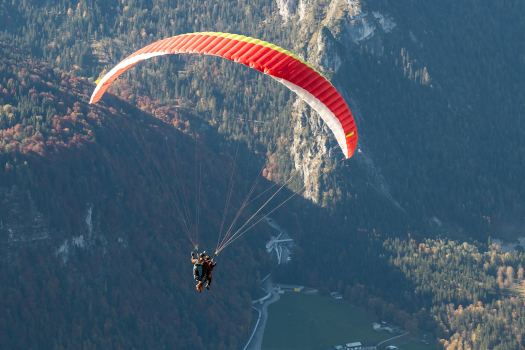
Drag, also referred to as fluid resistance, is a physical force that opposes the motion of an object[1][2] as it moves through a fluid medium, such as air. When an object travels through the air, the air molecules interact with its surface and create a force of fluid resistance that acts in the opposite direction to its movement. For instance, when launching a paper plane, you can observe how air resistance affects its flight, causing it to gradually lose altitude. This real-life example highlights the impact of fluid resistance on the trajectory and deceleration of objects moving through air or other fluids. The magnitude of fluid resistance depends on various factors such as the object’s speed, size, and shape.[3][4][5]
Examples
Paper plane

When a paper plane is thrown into the air, it experiences air resistance or drag force.[6][7] This force, exerted by the air, acts in the opposite direction of the plane’s motion and slows it down. As the paper plane flies forward, the air resistance opposes its movement, causing it to decelerate. The greater the speed of the paper plane, the more significant the effect of air resistance becomes, hindering its forward motion.
Paragliding

When a parachutist jumps from a height and opens the parachute during paragliding, the air resistance or drag force comes into play. As the parachutist descends, the surrounding air opposes the motion by exerting an upward force known as air resistance. This force acts in the opposite direction to the force of gravity and slows down the descent of the parachutist. The larger surface area of the parachute increases the amount of air resistance experienced. As a result, the parachutist can enjoy a controlled and gentle descent, safely gliding through the air and ultimately landing smoothly on the ground.
Bicycle ride

When a bicycle rider moves forward into a headwind, the force exerted by the air in the opposite direction slows down the speed of the bicycle. This force is known as air resistance or drag force. It acts as a hindrance and reduces the forward motion of the bicycle. The magnitude of air resistance depends on factors such as the rider’s speed, the density of the air, and the shape of the bicycle and rider.
Airplane

During flight, an airplane experiences air resistance or drag force. As the airplane moves forward, the air exerts a force on its body in the opposite direction, slowing down the plane.[5][8] This force, caused by the interaction between the airplane and the surrounding air, is known as air resistance.
Falling leaf

When a leaf falls from a tree, it experiences the effect of air resistance. The air surrounding the leaf generates an upward force on it, countering the force of gravity pulling it downward. This air resistance enables the leaf to float in the air for a period of time before it eventually descends and lands on the ground.
Floating paper

When a piece of paper is dropped, it experiences air resistance. As the paper falls, the air pushes against it in the opposite direction, creating an upward force that counteracts gravity’s pull. This opposing force, known as air resistance, causes the paper to slow down its descent and float in the air for a period of time before eventually reaching the ground.
Moving car

When a hand is extended out of a moving car, it encounters air resistance. As the car moves forward, the air in front of the hand pushes against it in the opposite direction, causing the hand to experience a backward force. This opposing force, known as air resistance, acts against the motion of the hand and creates a sensation of resistance against the airflow.
Flower petals

When flower petals descend towards the ground, gravity acts upon them and pulls them downward. Simultaneously, the surrounding air applies an upward force on the petals, enabling them to linger in the air. This upward force, referred to as air resistance, counteracts the downward pull of gravity and allows the petals to float temporarily before eventually settling on the ground.
Walking

When individuals walk in heavy, gusty wind, they often experience the sensation of being pushed backward by the air. This resistance force exerted by the air, which acts in the opposite direction of their movement, is commonly known as air resistance.
Related
- Drag equation
More topics
References
- Intro to air resistance – University of Colorado Boulder
- Drag – University of California Museum of Paleontology
- The dependence of air resistance on velocity – Rochester Institute of Technology
- Physics 101 – Hunter College
- Forces on an Airplane – NASA (.gov)
- THE SCIENCE OF FLYING – Chandra X-ray Observatory
- The Science Behind Paper Airplanes – Sites at Penn State
- What is air resistance? – Smithsonian Institution
External links
- Air Resistance: Definition & Examples – Study.com
- Air Resistance – Weebly
- Air Resistance: Definition, Formula & Example – Vaia
- What are some examples of air resistance? – Quora
- Drag (physics) – Wikipedia
- Free Fall and Air Resistance – The Physics Classroom
- Air Resistance, Drag Force, and Velocity: How Falling Works – Wondrium Daily
- BSL Physics Glossary – air resistance – definition – Scottish Sensory Centre
- Air Resistance – Primary Science Online
- Air Friction – HyperPhysics Concepts
- Friction and resistance – TheSchoolRun
- Air Resistance Formula – SoftSchools.com
- Air Resistance: Definition, Types, and Factors Affecting – What’s Insight
- Air Resistance and Drag – TeachPE.com
- What are water and air resistance? – BBC
- Non example of air resistance? – Answers
- Air and fluid resistance (article) | Forces – Khan Academy
- HOW DO YOU EXPLAIN AIR RESISTANCE – My World Their Way
- Air Resistance STEM Activity in 10 Mins or Less with Air Foils! – Little Bins for Little Hands
- How to Calculate Air Resistance – Science Struck
Deep
Learnool.com was founded by Deep Rana, who is a mechanical engineer by profession and a blogger by passion. He has a good conceptual knowledge on different educational topics and he provides the same on this website. He loves to learn something new everyday and believes that the best utilization of free time is developing a new skill.
